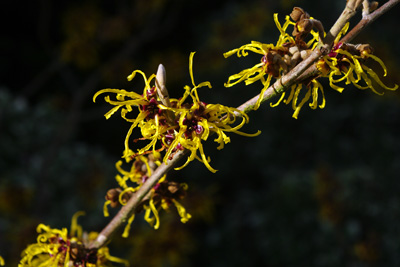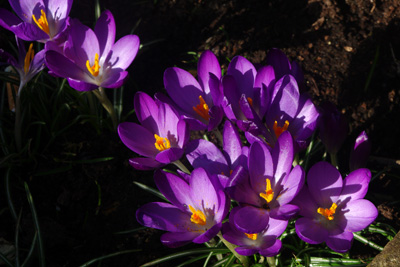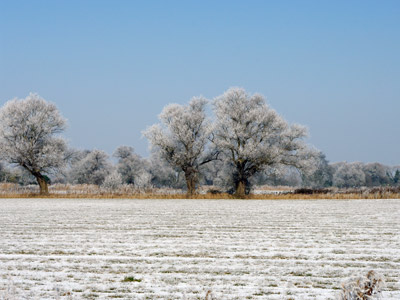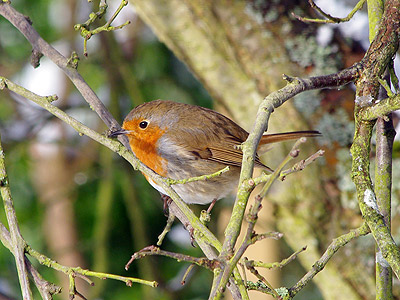The Garden in February - Jobs and Tips
plants for February
Jobs / Tips
One of the quietest months in the garden, not much to do and if you haven't done it, the weather often makes it fairly unpleasant to start. For the hardy souls though, there are jobs and it can even be pleasant on a calmer, warmer day.
![]() Time to prune your pomes, but leave your drupes well alone.
A pome is a fruit with pips, apples and pears (also quince and
medlars) whereas a drupe is a fruit with a stone, plums, cherries,
peaches and apricots.
Time to prune your pomes, but leave your drupes well alone.
A pome is a fruit with pips, apples and pears (also quince and
medlars) whereas a drupe is a fruit with a stone, plums, cherries,
peaches and apricots.
The dormant winter months are an ideal time to prune the over congested spurs from pome fruits. Apples and pears are mainly spur-fruiting, meaning that the fruits are produced on short lateral branches some 6-12 inches long. When a tree has been growing for some time, these spurs become over-crowded. The result is a rather untidy looking tree, lots of blossom and lots of small and not very high quality fruit. Reducing the spurs won't increase the overall yield, but you will get a good improvement in the size and quality of the fruit that form.
Remove older more complicated growth and thin weak stems leaving young vigorous growth behind. You should aim to remove about a third of the spur stems. If you repeat this process every year or two, then the tree will eventually be fruiting only on wood that is no more than a few years old.
If you have a very overgrown tree where the fruit is being borne further and further from the trunk, it's a good idea to perform some more drastic pruning. Rather than trying to trim the spurs, you need to cut them all off and about a third of the branch too. Cut back to a fork, and just do 1/3rd of the branches this year and complete it over the next two years.
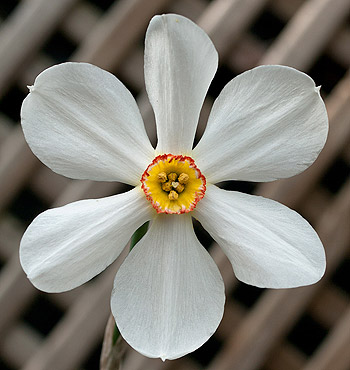
![]() Make plans, consider plants and planting. Use canes
or a hose pipe on the garden mark out planned beds, patios or
other features, then ignore them for a few days, look out of
the window and reconsider. Take your time when deciding on your
grand design and get it right before you start when the warmer
weather and breaking buds tempt you beyond the confines of the
fire-side.
Make plans, consider plants and planting. Use canes
or a hose pipe on the garden mark out planned beds, patios or
other features, then ignore them for a few days, look out of
the window and reconsider. Take your time when deciding on your
grand design and get it right before you start when the warmer
weather and breaking buds tempt you beyond the confines of the
fire-side.
![]() A good time to get a
patio or
deck ordered and laid. You'll
get it done sooner and possibly cheaper than later on. Make
your mind up and order from a contractor in March and the chances
are that by the time you move up the queue, you may not get
to sit out until June. Hard areas outside extend the season
of use of the garden. Lunch alfresco on a warm April day surrounded
by the fresh green shoots of spring is a real delight.
A good time to get a
patio or
deck ordered and laid. You'll
get it done sooner and possibly cheaper than later on. Make
your mind up and order from a contractor in March and the chances
are that by the time you move up the queue, you may not get
to sit out until June. Hard areas outside extend the season
of use of the garden. Lunch alfresco on a warm April day surrounded
by the fresh green shoots of spring is a real delight.
![]() Feed and continue to
feed the birds. This gets more
important as winter goes on, it's been a long time since much
wild food grew and it's a while still until there's anything
new. Don't forget on the warmer days too, hunger isn't nice
whatever the temperature.
Feed and continue to
feed the birds. This gets more
important as winter goes on, it's been a long time since much
wild food grew and it's a while still until there's anything
new. Don't forget on the warmer days too, hunger isn't nice
whatever the temperature.
![]() Stay off the grass when it frosty. It will recover if
left to thaw out, but walking on it can damage many of the blades.
Stay off the grass when it frosty. It will recover if
left to thaw out, but walking on it can damage many of the blades.
![]() Order seed catalogues and plan what you'll grow from seed
this year.
flower seeds,
vegetable seeds
Order seed catalogues and plan what you'll grow from seed
this year.
flower seeds,
vegetable seeds
![]() Main tree and hedge planting time (still). The
winter months are the best time to plant any trees and hedging
or other bare-rooted shrubs. These are bought bare-rooted from
nurseries, this way they will be dormant, but have a more extensive
root system than those grown in containers. They should be planted
as soon as you can so they spend the minimum time out of the
ground. This applies in particular to ornamental cultivars
which seem to be less tolerant than most.
Buy hedging plants
Main tree and hedge planting time (still). The
winter months are the best time to plant any trees and hedging
or other bare-rooted shrubs. These are bought bare-rooted from
nurseries, this way they will be dormant, but have a more extensive
root system than those grown in containers. They should be planted
as soon as you can so they spend the minimum time out of the
ground. This applies in particular to ornamental cultivars
which seem to be less tolerant than most.
Buy hedging plants
|
Tip. Use an old pair of tights as a tree tie. They're strong, don't rot, are soft and cheap. Tie around the tree and stake in a figure of 8 so that the tree trunk doesn't rub against the stake. |
If you can't plant bare rooted trees or hedging plants
straight away, then "heel them in". This means cover the roots
with soil in a temporary position so that they don't rot or
dry out. Don't be tempted to leave them in the bag or other
wrapping even for a short time. If you haven't space to put
them in the soil, then "planting" them in sharp sand (a couple
of quid for a bag from a builders merchant) will do nearly as
well (but dries out quicker than soil). You could even do this
in a bucket or other container as long as there are drainage
holes in the bottom so the roots don't sit in water.
Why bother? Why not wait until it's a bit warmer and more pleasant and plant out of containers?
1/ Bare rooted trees and shrubs are cheaper, as little as half the price for trees and cheaper than this for shrubs though the range of available shrubs is smaller, so you can either save money or spend the same and get a much bigger plant.
2/ Planting now means that they get off to the best possible start in the spring. As soon as the plants wake up and start putting their roots out, they're already in your soil rather in a pot that will then planted in the soil later, one less jolt to the system.
![]() Baby plants - a warning
Baby plants - a warning
Fairly soon and certainly before the end of the month, the garden centres and supermarkets will be trying to sell us "plugs" and "superplugs" of half hardy plants. These are small plants, often little more than a few weeks old, seedlings or rooted cuttings of summer bedding and basket plants. They appear to be good value - just a couple of pounds or so for 6 or 12 plants when later on in April larger versions will be the same for single plants.
But be careful when these little mites look at you with their soulful little leaves and temptation of fantastic value. The reality is that unless you make quite a lot of effort and / or have a heated greenhouse, you're better off waiting until later in the year even if it does mean paying more.
Small half hardy's such as Pelargoniums (Geraniums) Fuchsias and myriad others, are demanding unless you're equipped for them. You won't be able to plant them outside until later in May at the earliest, if you buy many now, you'd better have lots of protected space!
I fell for this a few years ago and bought some Busy Lizzie (Impatiens) seedlings in a pot, brought them home, potted them up and looked after them while keeping an eye on the sizes and price in the garden center I got them from. Come April, those leaving the nurseries where they had been given optimal conditions were larger than mine and worked out cheaper as well taking the compost and pots into consideration (not to mention the time and effort).
The main advantage of buying them like this is that you are more likely to get a large number of one particular colour or variety. If you buy trays of mixed colours, then I wouldn't bother until later when they're larger and healthier than you can manage on a windowsill.
Copyright 2000 - present. All Rights Reserved | Privacy Policy Statement

